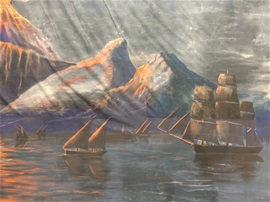 n 1847, a volcanic eruption at Fogo Island, Cape Verde. I love that you can see small folds in the cotton scroll. It was hung statically as it is too fragile to crank. Photo by Sue Truman.
n 1847, a volcanic eruption at Fogo Island, Cape Verde. I love that you can see small folds in the cotton scroll. It was hung statically as it is too fragile to crank. Photo by Sue Truman.
All the large 19th century moving panoramas were painted on fabric. One of the few surviving examples is the Grand Panorama of a Whaling Voyage Round the World, housed at the New Bedford Whaling Museum in New Bedford, MA.
The scroll was painted with water-based, distemper
paint on cotton sheeting in 1848. It measures 1,275' in length and 8.5' in height making it the longest surviving moving panorama from that era. A few sections of the painting were revised/painted over by the artist. Revisions were not uncommon in those
days. After performing the panorama, he might have gotten more ideas based on the audience's reactions.
Years of wear and tear took a toll on the painting. The paint was flaking off
in some sections, leaving some of the original artwork exposed. The museum made the decision to leave it alone so that we could see a bit of the editing process.
The moving panorama
was on display July-October, 2018. Read more about it here.